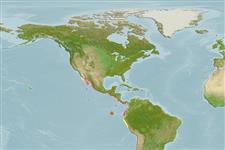Teleostei (teleosts) >
Eupercaria/misc (Various families in series Eupercaria) >
Lutjanidae (Snappers) > Lutjaninae
Etymology: Lutjanus: Malay, ikan lutjan, name of a fish.
More on authors: Nichols & Murphy.
Environment: milieu / climate zone / depth range / distribution range
Ecology
Marine; reef-associated; depth range ? - 40 m (Ref. 9313). Tropical; 28°N - 17°S, 115°W - 74°W (Ref. 55)
Eastern Pacific: Mexico to Peru.
Length at first maturity / Size / Weight / Age
Maturity: Lm 38.0 range ? - ? cm
Max length : 95.0 cm TL male/unsexed; (Ref. 9313); common length : 50.0 cm TL male/unsexed; (Ref. 55); max. published weight: 5.8 kg (Ref. 40637)
Dorsal spines (total): 10; Dorsal soft rays (total): 13 - 14; Anal spines: 3; Anal soft rays: 8. Preorbital bone very broad in adults. Large specimens develop a groove from front of eye to nostrils, and on upper part of preopercle behind the eye. Preopercular notch and knob weak. Scale rows on back rising obliquely above lateral line. Color mainly red to pink with a silvery hue; the fins reddish.
Adults are found over hard bottoms in inshore reef areas up to a depth of at least 80 m (Ref. 9313). Carnivorous, feed on big invertebrates and fish (Ref. 9313). They are marketed fresh or frozen because of excellent quality of flesh (Ref. 9313).
Life cycle and mating behavior
Maturity | Reproduction | Spawning | Eggs | Fecundity | Larvae
Allen, G.R., 1985. FAO Species Catalogue. Vol. 6. Snappers of the world. An annotated and illustrated catalogue of lutjanid species known to date. FAO Fish. Synop. 125(6):208 p. Rome: FAO. (Ref. 55)
IUCN Red List Status (Ref. 130435: Version 2024-1)
Threat to humans
Harmless
Human uses
Fisheries: subsistence fisheries; gamefish: yes
Tools
Special reports
Download XML
Internet sources
Estimates based on models
Preferred temperature (Ref.
123201): 22 - 28.6, mean 26.2 °C (based on 34 cells).
Phylogenetic diversity index (Ref.
82804): PD
50 = 0.5000 [Uniqueness, from 0.5 = low to 2.0 = high].
Bayesian length-weight: a=0.01479 (0.00706 - 0.03101), b=2.97 (2.80 - 3.14), in cm total length, based on LWR estimates for this Genus-body shape (Ref.
93245).
Trophic level (Ref.
69278): 4.0 ±0.62 se; based on food items.
Resilience (Ref.
120179): Medium, minimum population doubling time 1.4 - 4.4 years (K=0.15-0.26).
Fishing Vulnerability (Ref.
59153): Moderate vulnerability (40 of 100).
Nutrients (Ref.
124155): Calcium = 24.3 [15.2, 36.3] mg/100g; Iron = 0.299 [0.186, 0.454] mg/100g; Protein = 18.8 [17.3, 20.1] %; Omega3 = 0.116 [0.079, 0.167] g/100g; Selenium = 66.2 [43.4, 102.8] μg/100g; VitaminA = 91.6 [18.6, 329.7] μg/100g; Zinc = 0.36 [0.28, 0.50] mg/100g (wet weight);
